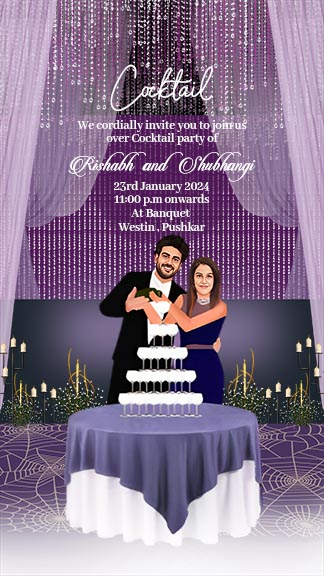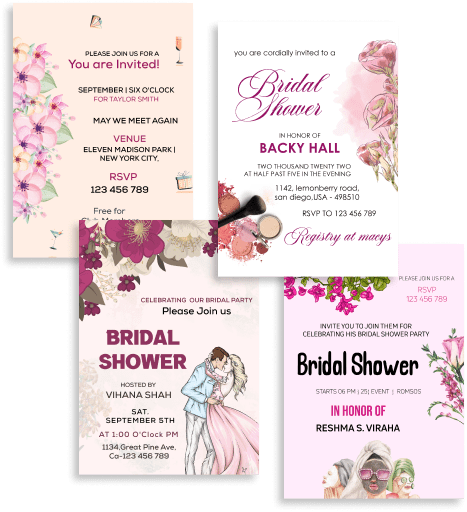
Modern Invitation Card Design: Trends and Techniques
Card invitation design has evolved significantly over the years, reflecting changes in technology, style, and consumer preferences. Today, modern invitation cards are a blend of artistic creativity, advanced printing techniques, and digital integration, creating captivating experiences for recipients. Whether you’re planning a wedding, corporate event, or a casual party, understanding the latest trends and techniques in invitation design can help you create stunning invitations that set the right tone for your event. This comprehensive guide explores the current trends and cutting-edge techniques in modern invitation card design.
The Evolution of Invitation Card Design
Traditional vs. Modern
Traditional invitation cards often relied on classic design elements like calligraphy, floral patterns, and formal language. These designs were typically printed on high-quality paper and sent via mail. Modern invitation cards, however, incorporate a wider range of materials, interactive elements, and digital technologies, offering more dynamic and personalized experiences.

The Role of Technology
Advancements in printing technology, design software, and digital tools have expanded the possibilities for invitation design. From laser cutting to augmented reality (AR) features, modern techniques allow for greater creativity and customization. This integration of technology not only enhances the visual appeal but also adds functional aspects like easy RSVPs and multimedia engagement.
Current Trends in Modern Invitation Card Design
Minimalist Aesthetics
Minimalism continues to be a popular trend in invitation design. This style is characterized by clean lines, simple color palettes, and a focus on essential elements. The use of white space, modern typography, and subtle textures creates an elegant and sophisticated look that is perfect for both formal and casual events.
Key Elements:
- Simple Color Schemes: Often monochromatic or featuring a limited palette.
- Clean Fonts: Sans-serif or modern serif fonts that enhance readability.
- Ample White Space: Allows the design to breathe and draws attention to key details.
Eco-Friendly Materials
With increasing awareness of environmental issues, many designers are opting for sustainable materials and practices. Eco-friendly invitation cards use recycled paper, plantable seed paper, or biodegradable materials. These options not only reduce environmental impact but also add a unique touch to the invitation.

Key Elements:
- Recycled Paper: Offers a natural, rustic look.
- Plantable Paper: Contains seeds that guests can plant, giving the Invitation design card a second life.
- Biodegradable Inks: Reduce the environmental footprint of the printing process.
Bold Typography
Typography is playing a more prominent role in modern invitation design. Bold, oversized fonts can create a strong visual impact and set the tone for the event. This trend often pairs with minimalist designs, where typography becomes the focal point of the invitation.
Key Elements:
- Oversized Fonts: Create a statement and draw attention.
- Unique Typefaces: Custom or unusual fonts that reflect the event’s theme.
- Typography as Art: Integrates text with graphic elements for a cohesive look.
Interactive Elements
Interactive invitations engage guests in ways that traditional cards cannot. Techniques like pop-up designs, sliders, or fold-outs add a tactile element that makes opening the invitation an experience in itself. Additionally, integrating digital elements like QR codes can provide easy access to additional information or event details.
Key Elements:
- Pop-Up Features: Create a three-dimensional aspect to the invitation.
- Sliders or Spinners: Add a playful, interactive component.
- QR Codes: Link to event websites, RSVPs, or multimedia content.
Digital Invitations
Digital invitations are becoming increasingly popular due to their convenience and cost-effectiveness. These invitations can be sent via email or social media and often include interactive features like embedded videos or clickable RSVPs. Digital invitations can be as simple or elaborate as printed ones and offer the added benefit of instant delivery and easy updates.

Key Elements:
- Embedded Media: Videos or slideshows that enhance the invitation.
- Clickable Links: Direct guests to RSVP pages or event details.
- Dynamic Design: Animated elements that capture attention.
Use of Texture and Layers
Adding texture and layers to invitation cards can create depth and interest. Techniques like embossing, debossing, and foiling add tactile elements that enhance the visual appeal. Layering different materials, such as vellum overlays or acrylic sheets, can also create a sophisticated and unique look.
Key Elements:
- Embossing/Debossing: Creates raised or recessed designs for a tactile effect.
- Foiling: Adds metallic accents that catch the light.
- Layering: Combines different materials or papers to add dimension.
Advanced Techniques in Modern Invitation Design
Laser Cutting
Laser cutting technology allows for intricate and precise designs that are difficult to achieve with traditional methods. This technique can be used to create detailed patterns, custom shapes, and unique textures, adding a luxurious and modern touch to your invitations.
Applications:
- Detailed Patterns: Lace-like designs or intricate motifs.
- Custom Shapes: Unusual shapes that reflect the theme of the event.
- Textured Layers: Adds depth and complexity to the design.
Augmented Reality (AR)
Augmented reality takes thread ceremony invitation card online free into the digital realm by adding interactive, multimedia elements. Using a smartphone app, guests can scan the invitation to access videos, animations, or other interactive content, providing a memorable and engaging experience.
Applications:
- Video Messages: Personalized greetings or event previews.
- Animated Graphics: Bring static elements to life.
- Interactive Maps: Directions or venue tours.
Watercolor and Hand-Painted Elements
Hand-painted invitations bring a personal and artistic touch to your design. Watercolor techniques can add a soft, organic feel, while hand-painted elements create a one-of-a-kind look. This approach is ideal for events that seek a unique and handcrafted aesthetic.
Applications:
- Custom Illustrations: Tailored to the event’s theme or location.
- Watercolor Washes: Soft backgrounds or accent elements.
- Artistic Details: Personalized touches that enhance the overall design.
Foil Stamping
Foil stamping adds a touch of elegance and luxury to invitation cards. This technique involves applying metallic foil to specific areas of the card, creating shiny, reflective elements that catch the eye. It is commonly used for text, borders, or decorative accents.
Applications:
- Text Accents: Highlighting names, dates, or headings.
- Borders and Frames: Adding a metallic outline or decorative edge.
- Decorative Motifs: Enhancing illustrations or graphic elements.

Practical Tips for Designing Modern Invitations
Define Your Audience and Purpose
Understanding your audience and the purpose of your event is crucial for designing effective invitations. Tailor the design to reflect the preferences and expectations of your guests. A corporate event might call for a sleek, professional design, while a child’s birthday party could benefit from playful and colorful elements.
Balance Aesthetics with Functionality
While it’s important to create visually appealing invitations, functionality should not be overlooked. Ensure that the invitation clearly communicates all necessary details and is easy to read. Avoid overcrowding the design with too many elements, which can detract from its effectiveness.
Choose the Right Tools
Selecting the appropriate tools and platforms can streamline the design process. Professional designers might use software like Adobe Illustrator or InDesign for advanced customization, while beginners can leverage user-friendly tools like Canva or PicMonkey for accessible, template-based design.
Test Different Formats
Experiment with different formats to find what works best for your event. Consider traditional printed invitations, digital formats, or a hybrid approach. Testing different designs can help you identify the most effective way to present your invitation and engage your guests.
Pay Attention to Details
Details like paper quality, printing techniques, and envelope presentation can significantly impact the overall impression of your invitation. Investing in high-quality materials and finishes can elevate the perceived value and professionalism of your invitation.
Embrace Feedback
Don’t hesitate to seek feedback from friends, family, or colleagues during the design process. Fresh perspectives can provide valuable insights and help you refine your design to better meet the expectations of your audience.
Case Studies: Modern Invitations in Action
Wedding Invitations
Theme: Modern Elegance
Design Elements: Clean lines, a monochromatic color scheme with metallic accents, and minimalist typography.
Techniques: Laser cutting for intricate patterns, foil stamping for metallic text highlights, and an AR feature that links to a video of the couple’s story.
Outcome: The combination of traditional elegance with modern technology created a memorable and engaging invitation that set the perfect tone for the wedding.
Corporate Event Invitations
Theme: Sleek and Professional
Design Elements: Bold typography, a neutral color palette with blue and grey tones, and high-quality paper with a matte finish.
Techniques: QR codes linking to an event app, debossing for the company logo, and a digital RSVP option.
Outcome: The modern design and interactive features conveyed professionalism and facilitated easy guest engagement, enhancing the overall event experience.
Birthday Party Invitations
Theme: Retro Arcade
Design Elements: Bright, playful colors, retro fonts, and fun graphics of classic arcade games.
Techniques: Pop-up elements for an interactive experience, hand-drawn illustrations for a nostalgic feel, and digital distribution for easy guest response.
Outcome: The vibrant and interactive design captured the theme perfectly and created excitement among guests, contributing to a lively and enjoyable party.
Conclusion
Modern invitation card design is a dynamic field that combines artistic creativity with technological innovation. By embracing current trends like minimalist aesthetics, eco-friendly materials, and interactive elements, you can create invitations that not only inform but also delight your guests. Advanced techniques such as laser cutting, augmented reality, and foil stamping offer endless possibilities for customization and engagement. Whether for weddings, corporate events, or casual parties, understanding these trends and techniques will help you design invitations that are elegant, effective, and reflective of your event’s unique character. Stay attuned to the evolving landscape of invitation design to create memorable experiences that leave a lasting impression.




Leave Your Comment